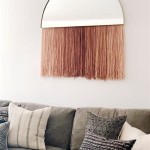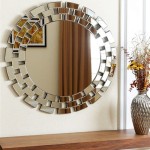DIY Mirror Backsplash: A Comprehensive Guide
A mirror backsplash can significantly enhance the aesthetic appeal of a kitchen or bathroom, creating a sense of spaciousness and reflecting light to brighten the area. Implementing a do-it-yourself (DIY) mirror backsplash project can be a cost-effective way to achieve this desired effect. This article provides a comprehensive guide on how to plan, prepare, and install a mirror backsplash, detailing the necessary materials, tools, and techniques for a successful outcome.
Before embarking on the project, careful planning is essential. This includes accurately measuring the backsplash area, selecting the appropriate type of mirror, and considering any design elements that will complement the existing décor. Thorough preparation of the surface is also crucial for ensuring proper adhesion and a professional-looking finish.
Key Point 1: Planning and Design Considerations
The initial phase of a DIY mirror backsplash project involves detailed planning, taking into account the dimensions of the space, the desired style, and practical aspects such as outlet placement. Accurate measurements are paramount to avoid costly errors and ensure a seamless fit. Use a reliable measuring tape and a level to determine the exact width and height of the area to be covered. It is advisable to create a sketch or diagram, documenting all measurements, including the position of electrical outlets and any other obstructions.
Choosing the right type of mirror is another critical decision. Options include standard clear mirrors, tinted mirrors (such as gray or bronze), and antiqued mirrors. Consider the overall color scheme of the room and the desired level of reflection when making this selection. Standard clear mirrors offer the brightest reflection and are suitable for smaller spaces that require enhanced illumination. Tinted mirrors provide a more subtle reflection and add a touch of sophistication. Antiqued mirrors offer a vintage aesthetic and can conceal minor imperfections.
The size and shape of the mirror pieces also need careful consideration. Large, single sheets of mirror provide a clean, modern look, but can be more challenging to handle and install, particularly in larger areas. Smaller, individual tiles or panels offer greater flexibility in design and are easier to manage. If using tiles, decide on the desired grout spacing and pattern. Common options include square, rectangular, and mosaic tile patterns.
Furthermore, the placement of electrical outlets and switches must be factored into the design. Consider whether to cut custom openings in the mirror or to install outlet extenders to bring the outlets flush with the surface of the mirror. Cutting mirror requires specialized tools and techniques, so it's generally recommended to have this done professionally by a glass shop.
Finally, consider the lighting in the area. The mirror will reflect existing light sources, so ensure that the placement of lights complements the backsplash and does not create unwanted glare or shadows. Undercabinet lighting can be particularly effective in enhancing the appearance of a mirror backsplash.
Key Point 2: Materials and Tools
The success of a DIY mirror backsplash project hinges on having the right materials and tools. A comprehensive list ensures a smooth and efficient installation process. The core material, of course, is the mirror itself, cut to the specifications determined during the planning phase. It is advisable to purchase the mirror from a reputable glass shop that can provide precise cuts and finished edges for a professional appearance.
Mirror adhesive is a critical component. This specialized adhesive is formulated to bond mirrors to various surfaces without damaging the reflective backing. It must be specifically labeled for use with mirrors to prevent issues such as desilvering, which can cause dark spots and discoloration. High-quality mirror mastic or a similar product is essential.
In addition to adhesive, double-sided mirror tape can be used to provide temporary support while the adhesive cures. This tape holds the mirror in place, preventing it from sliding or shifting during the drying process. Ensure the tape is strong enough to support the weight of the mirror.
Grout (if using mirror tiles) is necessary to fill the spaces between the tiles and create a uniform and waterproof seal. Choose a grout color that complements the mirror and the surrounding décor. Epoxy grout is a durable and stain-resistant option, particularly suitable for kitchen backsplashes.
A variety of tools are needed for surface preparation, installation, and finishing. These include:
*Measuring tape:
Essential for accurate measurements. *Level:
Ensures that the mirror is installed straight and even. *Caulk gun:
For applying the mirror adhesive and grout. *Notched trowel:
For evenly spreading the adhesive, especially when using large sheets of mirror. *Spatula or putty knife:
For smoothing out the adhesive and grout. *Grout float:
For applying and packing grout into the tile joints. *Sponges:
For cleaning excess adhesive and grout. *Clean cloths:
For polishing the mirror and removing smudges. *Safety glasses:
To protect the eyes from debris. *Gloves:
To protect the hands from adhesive and grout. *Utility knife:
For trimming tape and other materials. *Caulk smoother:
For creating a neat, professional-looking caulk bead.Optional tools that can be helpful include a laser level for ensuring accurate alignment and a glass cutter for making minor adjustments to the mirror (although, as mentioned previously, having a professional cut the mirror is highly recommended).
Key Point 3: Installation Process
The installation process requires careful attention to detail to ensure a secure and aesthetically pleasing result. The first step is to thoroughly prepare the surface to which the mirror will be adhered. This involves cleaning the surface to remove any dirt, grease, or loose paint. Fill any holes or imperfections with spackle or joint compound and sand smooth. Priming the surface can also improve adhesion, particularly on porous materials such as drywall.
Once the surface is prepared, apply double-sided mirror tape in vertical strips across the surface, approximately every 12 inches. This tape will provide temporary support while the adhesive cures. Next, apply the mirror adhesive to the back of the mirror. If using a large sheet of mirror, use a notched trowel to spread the adhesive evenly across the entire surface. If using smaller tiles, apply a dab of adhesive to the center of each tile.
Carefully position the mirror onto the prepared surface, aligning it with the marked guidelines. Press firmly to ensure good contact with the adhesive and the double-sided tape. Use a level to verify that the mirror is straight and adjust as needed. If using multiple tiles, maintain consistent spacing between the tiles using spacers.
Allow the adhesive to cure according to the manufacturer's instructions, typically at least 24 to 48 hours. During this time, avoid disturbing the mirror. Once the adhesive is fully cured, remove the spacers and proceed with grouting (if using tiles). Apply grout to the tile joints using a grout float, pressing firmly to pack the grout into the spaces. Remove excess grout with a damp sponge, working diagonally across the tiles.
After the grout has partially cured, use a clean, damp sponge to smooth the grout lines and remove any remaining grout residue. Allow the grout to fully cure according to the manufacturer's instructions, typically several days. Finally, polish the mirror with a clean, dry cloth to remove any streaks or smudges.
To finish the installation, apply a bead of caulk along the edges of the mirror where it meets the countertop or wall. This will create a waterproof seal and prevent water from seeping behind the mirror. Use a caulk smoother to create a neat, professional-looking caulk line.
By following these steps carefully and paying attention to detail, a DIY mirror backsplash can transform the look of a kitchen or bathroom, adding light, space, and style.

Framed Mirror Backsplash Cleverly Inspired

Mirrored Backsplash In The Kitchen Makerista

Damask Antique Mirror Diy Tutorial Salvaged Living

Dollar Tree Diy Removable Mirror Backsplash Accent Wall

Mirrored Backsplash In The Kitchen Makerista

Antique Mirror In The Kitchen A Storied Style

53 Mirror Backsplash Unique Stylish Reflective Backsplashes

Mirrored Backsplash In The Kitchen Makerista

Antique Mirror In The Kitchen A Storied Style

Dollar Tree Diy Removable Mirror Backsplash Accent Wall








